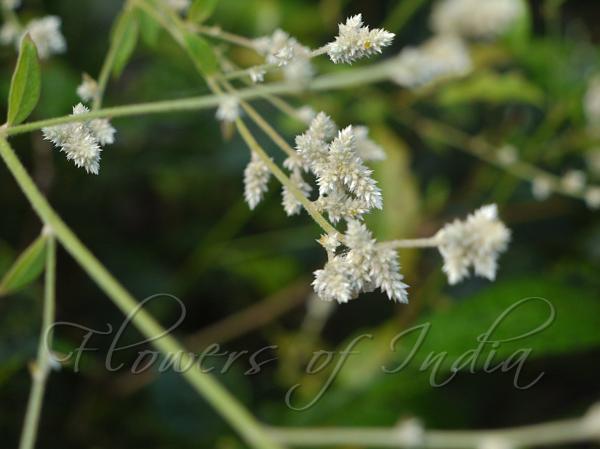|
| Climbing Wool-Plant |
|

|

| File size | 284058 |
| Original date | 12/12/09 7:53 AM |
| Resolution | 2048 x 1536 |
| Flash | Flash did not fire, auto |
| Focal length | 45.0mm |
| Exposure time | 1/60s |
| Aperture | 5.6 |
| Focus Distance | |
| Metering Mode | Multi-segment |
| Camera make | Panasonic |
| Camera model | DMC-G1 |
| Sensor type | OneChipColorArea |
|
|
|
|
Photo: |
Botanical name: Ouret sanguinolenta Family: Amaranthaceae (Amaranth family)
Synonyms: Achyranthes sanguinolenta, Aerva sanguinolenta, Aerva scandens
Synonyms: Achyranthes sanguinolenta, Aerva sanguinolenta, Aerva scandens
Climbing Wool-Plant is a perennial herb, frequently woody below, prostrate
to erect or frequently scrambling, 0.4-1 m. Stems are branched from the
base and usually also above, upper branches commonly long and slender.
Stem and branches are round, channeled, densely velvety with whitish or
yellowish hairs. Leaves are broadly to narrowly ellipitic or elliptic-
lanceolate or elliptic-ovate, narrowed to flat at the base, pointed to
long-pointed at the tip, densely whitish-woolly on both surfaces, about
1.5-18 x 0.8-6 cm, leaf-stalk up to 2 cm long. Branch and inflorescence
leaves gradually reduce upwards. Flowers arise in stalkless spikes,
forming a lax raceme or terminal panicle, 0.5-8 x 0.4-0.6 cm, cylindrical
(conical when young), silky, white to pale pink or pale brown. Bracts are
1-1.5 mm, deltoid-ovate. All are tepals densely woolly dorsally. Stamens
are delicate, at anthesis attaining about half the length of the style.
Capsule is about 1 mm. Seed 0.8-1 mm, kidney-shaped, black, shining.
Climbing Wool-Plant is found in the Himalayas, at altitudes of 150-1400 m,
and also in the Western Ghats.
| Identification credit: Satish Pardeshi, N.S.Dungriyal | Photographed at Yeoor Hills, Sanjay Gandhi National Park, Maharashtra. |
• Is this flower misidentified? If yes,